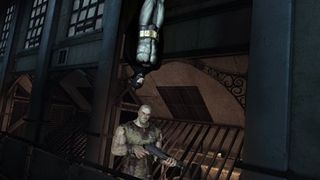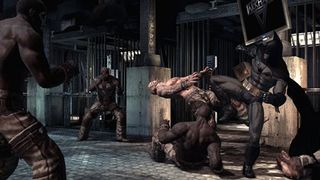Why Batman: Arkham Asylum is better than Splinter Cell, Metal Gear and Devil May Cry
How Batman is taking back the mantle from the games that stole his schtick
As good as the combat was, it was when the full-on stealth kicked in that it really became apparent how different Batman is to his videogame rivals. Through gadgets, tactics and overall Batman-ness, he surpasses their slow and steady, sneak and survive approach, instead making complete use of his environment for total dominance. Batman doesn't just beat the odds. He owns them, as we were taught during our run through one of Arkham's cavernous treatment facilities.

Starting in a shower block off to the side, a quick scan with the Detective Mode visor tells us that a lone grunt is patrolling nearby. Easy pickings to warm up with. Stepping into the cover of a shower cubicle, we throw a sonic batarang into a nearby pillar and wait. Sure enough, the goon shuffles in to investigate the sound, like a big ugly moth to massively painful flame.
As he unwittingly turns his back on us to check out the source of the noise, we silently step out behind him, and one crunching sleeper hold later he's out of the game. One down, four to go. The rest don't even know he's missing yet. We carefully step out into the main room and use the fast and intuitive target lock to grapple soundlessly up to a gargoyle close to the ceiling.
There's an oblivious henchman guarding a nearby gantry below. As he gets closer, we're offered the context-sensitive option of a gliding kick and we take it, swooping down to clobber him in the back of the head and disappearing back into the ceiling a second later. He's down but not out, and everyone now knows that we're here. But this a good thing. They're noticeably scared, and scared people make mistakes. They begin grouping together, but we have ways of breaking up the party. Time to really start spinning the web.

The visor tells us that one of the small treatment rooms below has a structurally weak ceiling, so we swing over to set a trap, silently dropping onto the roof to lay some explosive gel. It's a good trap, but it needs bait, so we grapple further away to get a shallow throwing angle and put another sonic batarang in through the doorway. Sure enough, an unlucky goon takes the bait and breaks away from the pack to investigate. Click. Boom. He's down. But this is just layer number one of a great big cake o' pain.
Spotting a convenient gargoyle directly over the new hole in the ceiling, we get over to it and tap B to dangle upside down underneath, ready to drop on the next thug as he investigates the wreckage. Having dragged him back up into the shadows, knocked him out and strung him up under the gargoyle, we swing away for a better vantage point of our new pinata. Noticing that the increasingly shaky penultimate hood is walking over to check out where his buddy went, we're struck with an idea. Just to see if it will work, we wait for the new guy to walk underneath his stricken comrade, and throw a batarang at the rope suspending our previous victim, hoping that the game will allow us to cut him loose. Brilliantly, it does and the weighty slab of thug plummets to flatten his would-be helper.

With only one enemy left, we can afford to take our time. A visor scan tells us that his heart is racing, compounding the obvious visual clues that the poor guy is terrified out of his mind. Naturally, we decided to f*ck with him for a while, and spend the next couple of minutes dropping in and out of the room and throwing batarangs out of the shadows to freak him out. In his panic, he repeatedly blind-fires into dark corners of the ceiling we are no longer in. With a chuckle, we swoop in for the final takedown. Job done.
Sign up to the GamesRadar+ Newsletter
Weekly digests, tales from the communities you love, and more
Except that the whole process was so addictive that we couldn't just leave it there. With so many options to explore, there were a stack of different approaches we could have taken. We could have used an air vent to creep around inside the walls, setting explosive gel to blow the brickwork back into the room. We could have detonated it from the rafters, taking out a passing psycho with the debris while nigh-simultaneously using the diversion of the blast to get the drop on his suddenly distracted partner. Just like with the fighting, the accessibility and number of options kept us going back to clear the room in every way we could concoct for over an hour, outsmarting both the AI and ourselves by reinventing our approach and trying to improve our clear time and efficiency.

Earlier, non-playable demos had given us fears that Arkham Asylum's gameplay was going to be rather too simplistic, pre-scripted and linear, the straightforward, context-sensitive controls in particular making us worry that it was all going to be a case of "Go here, press this, do this to progress". Thankfully, the truth is far from it. Arkham Asylum seems to be all about using simple tools to facilitate massive tactical freedom, all portrayed in as quintessentially Batman a manner as you could hope for. We're now very, very excited indeed about the prospect of playing through these elements in the more integrated environs of the main campaign, where we're promised we'll be even more free to experiment and mix things up on the fly. When we get to play more, we'll fill you in. Until then, same bat-time, same bat-channel.

Oh, that's why the Stellar Blade devs were terrified by demo players: one fan's spent "about 60 hours" maxing Eve's skill tree before the action RPG is even out

A new Taylor Swift song mentions GTA, but some remember it mentioning Baldur's Gate 3, Final Fantasy 14, and more in hilarious Twitter trend
Most Popular





